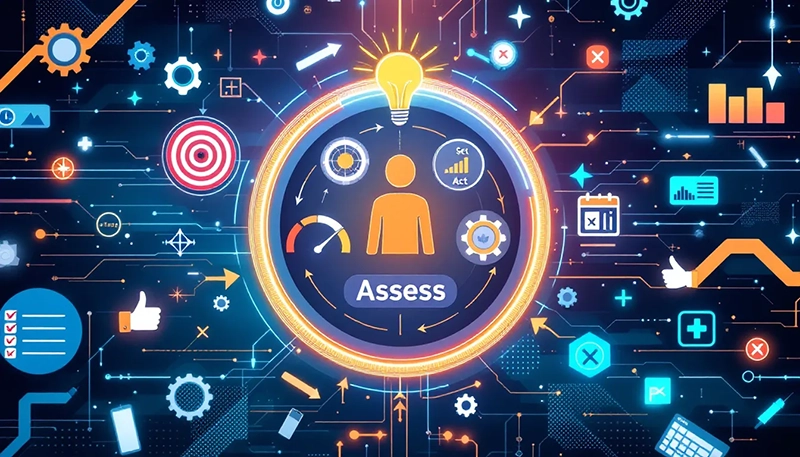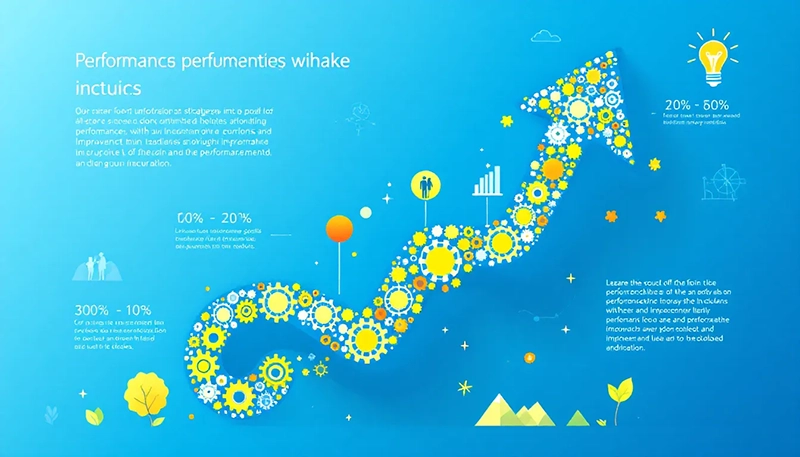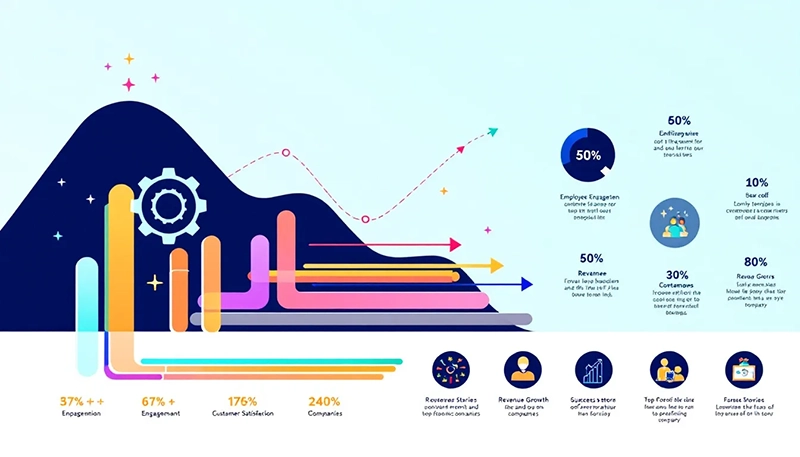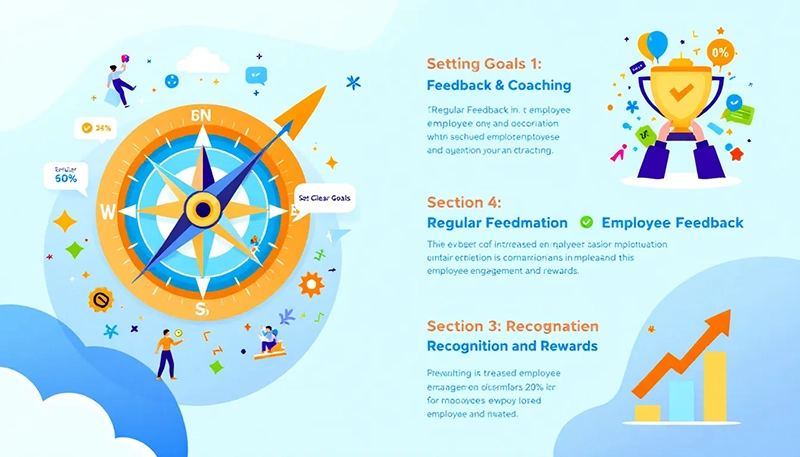
A performance improvement plan (PIP) is a structured approach aimed at improving employee performance. It outlines specific areas where improvement is needed, sets measurable goals, and provides the necessary support for employees to meet these targets. This article will walk you through the essential steps of creating, implementing, and monitoring an effective PIP to ensure success.
Key Takeaways
-
Performance Improvement Plans (PIPs) are structured interventions aimed at helping underperforming employees improve through clear goals, support, and progress tracking.
-
Effective PIPs should involve HR approval, regular check-ins, and documented progress to foster accountability and ensure fair treatment of employees.
-
Engaging employees in goal-setting and maintaining open communication throughout the PIP process enhances their commitment and motivation to improve performance.
Understanding Performance Improvement Plans
Performance Improvement Plans (PIPs) are formal documents designed to assist employees who are not achieving their job performance targets. The primary purpose of a performance improvement plan pip is to address performance issues, set specific goals, and provide the necessary support to help employees improve.
PIPs outline specific performance deficiencies and set clear expectations for future conduct within a designated timeframe. They typically include specific goals and milestones to track progress, ensuring that timely improvements are made to address performance failures.
A structured framework in PIPs enables managers to assist employees in improving their performance.
What is a Performance Improvement Plan?
A performance improvement plan (PIP) is a formal document that outlines an employee’s performance deficiencies, along with a timeline and goal-oriented plan to help them improve. It is a tool used by employers to address employee performance issues, provide clear expectations, and support employees in achieving their goals. The primary objective of a PIP is to help the employee succeed in their role by identifying areas for improvement, providing guidance and resources, and monitoring progress.
A PIP typically includes specific goals and objectives, a timeline for achieving those goals, and a description of the resources and support needed to help the employee improve. It also outlines the process for monitoring progress, providing feedback, and evaluating the employee’s performance. The plan is usually developed in collaboration with the employee, their manager, and HR, to ensure that everyone is on the same page and working towards the same objectives.
The purpose of a PIP is to provide a structured approach to addressing performance issues, rather than simply criticizing the employee’s performance. By focusing on specific areas for improvement and providing clear expectations, a PIP can help employees understand what they need to do to succeed in their role. It can also help managers to identify and address any underlying issues that may be contributing to the employee’s performance deficiencies.
In addition to addressing performance issues, a PIP can also be used to support employees who are struggling to meet their goals due to lack of training or resources. By providing additional support and guidance, a PIP can help employees to overcome obstacles and achieve their full potential.
Overall, a performance improvement plan is a valuable tool for employers who want to support their employees in achieving their goals and improving their performance. By providing clear expectations, guidance, and resources, a PIP can help employees to succeed in their roles and contribute to the success of the organization.
Benefits of Performance Improvement Plans
Structured support through performance improvement plans enhances employee engagement. They help employees understand and overcome their shortcomings while facilitating their growth. Addressing performance issues constructively through PIPs can boost overall employee performance and create a more positive work environment.
When to Use a Performance Improvement Plan
Performance improvement plans are designed to assist employees who need help improving their work performance, particularly when an employee fails to meet their goals or make significant errors. They are appropriate when employees consistently fail to meet their goals or make significant errors. A specific performance issue such as consistently missing deadlines for assigned tasks and projects warrants the implementation of a PIP. Performance improvement plans work effectively in addressing these challenges.
However, it is important to note that behavioral issues, such as insubordination and harassment, are not suitable for a performance improvement plan.
Steps to Create an Effective Performance Improvement Plan

To create an effective Performance Improvement Plan, start by evaluating the employee’s current performance to determine if a PIP is needed. Then, develop clear performance goals using the SMART criteria to guide progress.
Once the goals are set, draft the PIP document, including specific support mechanisms and a milestone schedule. Finally, have the HR department review the PIP to ensure fairness and feasibility.
Evaluate Employee’s Current Performance
Conducting a thorough assessment of an employee’s performance involves gathering feedback from various sources, including clients and coworkers. It is essential to identify performance issues with neutrality and rely on factual data rather than personal opinions. Analyze the employee’s work habits, skills, and environment to determine the root causes of the performance deficiencies.
Combining all gathered data helps evaluate the necessity of a Performance Improvement Plan. This comprehensive assessment will help you understand the specific areas where the employee needs improvement and set the stage for developing a tailored improvement plan.
Develop Clear Performance Goals
Setting specific goals in a performance improvement plan ensures that employees have a clear understanding of what is expected. A structured plan clarifies expectations and breaks down complex objectives into manageable goals to guide employees effectively. Establishing SMART goals—specific, measurable, achievable, relevant, and time-bound—helps in guiding the employee’s progression.
These clearly defined goals should be included in the PIP document along with the strategies the employee will use to achieve them. Providing clear expectations helps employees understand what they need to do to meet their performance targets.
Draft the Performance Improvement Plan Document
A Performance Improvement Plan should include successful goals, success criteria, and employee response strategies. Incorporating the employee’s input during the drafting process ensures that the plan is realistic and considers the employee’s perspective. Support in a PIP might involve training courses, mentorship, and coaching to aid in employee performance enhancement. The PIP document can be formatted as a letter or a standard form to ensure clarity and professionalism.
Training and mentorship are crucial components of support in a PIP for employee development.
A typical milestone schedule for monitoring a performance improvement plan is set at 30, 60, and 90 days. This structured approach helps in tracking progress and making necessary adjustments. These milestones provide clear checkpoints to evaluate the employee’s progress and ensure timely interventions if needed.
HR Department Review
HR professionals should ensure that the PIP is fair and its goals are attainable. HR reviews should focus on ensuring that PIP goals are achievable and the process is fair to the employee. The employee’s supervisor typically prepares the performance improvement plan and submits it to HR for review. The HR department provides templates, guides the creation, and tracks the progress of the PIP.
Investigating underlying reasons for performance issues can inform decisions on next steps after a PIP. This thorough review process helps in creating a supportive environment for the employee’s development. When PIPs fail to address underlying organizational issues, they are less likely to succeed, highlighting the importance of addressing systemic problems alongside individual performance.
Implementing the Performance Improvement Plan

Implementing a Performance Improvement Plan requires a careful and considerate approach. Employees may misinterpret a PIP as a sign that termination is imminent, which can increase their stress levels. Most employees perceive PIPs as a sign that their termination is imminent. Therefore, it is crucial to approach the process with care and consideration, applying a collaborative coaching strategy to make the PIP process effective.
Ongoing coaching and development foster a supportive and collaborative environment for employees. Consistent monitoring of an employee’s progress provides unbiased data that helps managers understand employee strengths and weaknesses. Continuous communication between managers and employees fosters a culture of trust and improves performance outcomes.
Open communication and support throughout the process can enhance employee commitment to the PIP.
Conduct the PIP Meeting
Meeting with the employee during the PIP process is essential to provide context and clarify any misunderstandings. Effective communication is a key component of implementing a Performance Improvement Plan. Open dialogue during the PIP meeting can significantly enhance employee engagement.
The manager’s role during a PIP involves providing support, training, and continuous guidance to ensure success. Both the manager and employees need to sign the completed PIP, which should be approved by HR. This process ensures that both parties are committed to the plan and its objectives.
Regular Check-ins and Feedback
Regular check-ins are vital for monitoring progress and providing ongoing support. These meetings help to ensure that the employee has the necessary tools and training to meet their goals. PIPs should include a timeline with scheduled check-in meetings to monitor employee progress effectively. Regular feedback sessions are critical for evaluating employee progress and addressing any challenges during a PIP.
Ongoing discussions between managers and employees can significantly improve the effectiveness of a performance improvement plan. Creating an environment where employees feel safe to express their concerns can improve the effectiveness of a PIP.
Positive Reinforcement and Support
To motivate employees effectively, use positive reinforcement as a strategy to encourage desired performance. Managers should actively connect with employees and provide support to help them reach performance goals.
Recognizing and celebrating small achievements during the PIP can boost employee motivation and confidence.
Monitoring and Documenting Progress

Tracking employee progress through key performance indicators helps managers assess improvement effectively. Managers can view and follow the employee’s progress to determine if goals are being met. Accurate document progress of challenges faced during the performance improvement process helps in evaluating the effectiveness of the PIP.
It is crucial to record the date of discussions, individuals present, key points, and follow-up actions in performance reviews. This detailed documentation ensures transparency and accountability throughout the PIP process.
Performance Reviews and Adjustments
Evaluations enhance workplace productivity by recognizing employee contributions and addressing areas needing improvement. Performance assessments every few months enable timely adjustments to the improvement plan.
Ongoing communication and regular feedback are necessary for effective feedback during the PIP process.
Documenting Progress and Challenges
Keeping detailed records of the employee’s progress throughout the PIP is crucial for transparency and accountability. Documentation should include records of performance deficiencies, previous warnings, and performance review documents to provide context on employee progress.
Recognizing successful employee’s progress throughout the PIP period is an effective way to motivate the employee and encourage further development.
Concluding the Performance Improvement Plan
Concluding a Performance Improvement Plan is a critical step in ensuring the long-term success of the employee. More than half of employees show enhanced performance after successfully completing a performance improvement plan. Upon receiving a performance improvement plan, employees should have an honest conversation with their manager about their goals and expectations. At the end of a PIP, it is essential to arrange a closing meeting to review progress and discuss next steps. This meeting indicates that the employer values the employee’s role and wants to support their development.
The typical time frame for assessing improvement in a performance improvement plan is between 30 to 120 days. This period allows sufficient time for the employee to make meaningful changes and for the manager to assess progress accurately. However, the success rate of employees surviving a PIP is often low, and they can be stressful for all parties involved, making it essential to handle the process with care.
Successful Completion
Celebrating the goals achieved and outlining future performance expectations are crucial steps after a successful PIP. If the employee successfully meets the PIP’s objectives, the PIP is closed, and the employee’s success is recognized. Acknowledging the completion of a PIP should emphasize the improvements made by the employee.
The employee then returns to work as usual with follow-up to ensure employee succeed sustained performance.
Extension or Further Action
Should an underperforming employee fall short of PIP objectives but show commitment, consider extending the plan to provide more time for improvement. However, if the employee does not improve or their performance worsens, close the PIP and consider reassignment, demotion, or termination.
When deciding next steps, consider flexibility in consequences, time, and effort to support the employee. Potential consequences if an employee does not complete their PIP include transfer, demotion, or termination.
Tips for a Successful Performance Improvement Plan

Ensuring the success of a Performance Improvement Plan involves several key strategies. Recognizing achievements during the PIP is important for reinforcing positive employee behavior and encouraging sustained performance. If an employee demonstrates commitment but does not meet PIP objectives, extending the plan can provide additional support. Future discussions after a PIP should focus on continuous development and potential new goals. Setting new performance expectations post-PIP helps maintain employee engagement and motivation.
HR leaders can contribute to employee development by helping managers foster a coaching mindset and actively listening to employees during performance improvement meetings. The purpose of the PIP meeting is to review the plan and timelines while encouraging support.
After the PIP meeting, it may be necessary to modify the plan based on employee’s input. A positive environment is nurtured through active employee input during the PIP process.
Involve Employees in the Process
Engaging employees in the PIP process can lead to increased commitment to achieving performance goals. Active participation of employees in setting goals during a PIP can significantly enhance their engagement and commitment to improvement.
Collaborate with employees to develop the PIP and ensure they understand the goals and expectations. This involvement fosters a sense of ownership and commitment. Employees thrive when they know their expectations and are held accountable for their performance, which can lead to better outcomes and increased engagement.
Focus on Skill Gaps and Training Needed
Identifying specific skill deficiencies is essential to tailoring training resources effectively. Identifying specific skill deficits and providing targeted training resources help employees reach their potential.
Addressing skill gaps through targeted proper training can significantly enhance employee performance and overall effectiveness. Focusing on strengths allows employees to recognize and build on their capabilities, which can further boost their confidence and productivity.
Encourage Open Communication
Poor communication leads to errors and confusion in employee performance. A performance improvement plan can negatively impact the manager-employee relationship, potentially leading to poor performance and underperforming employees leaving before being fired. PIPs often generate feelings of insecurity and fear in employees, which can further strain the relationship and hinder improvement efforts.
Encouraging open communication and providing a safe environment for employees to express their concerns can significantly improve the effectiveness of a PIP.
Summary
Performance Improvement Plans are an essential tool for addressing performance issues and fostering employee development. By understanding the benefits of PIPs, knowing when to use them, and following a structured approach to creating and implementing them, managers can help employees overcome performance deficiencies and achieve their goals.
Effective PIPs involve evaluating current performance, setting clear goals, drafting a comprehensive document, and conducting regular check-ins and feedback sessions. By involving employees in the process, focusing on skill gaps and training, and encouraging open communication, managers can create a supportive environment that motivates employees to improve and succeed. With the right strategies and a commitment to continuous development, PIPs can lead to significant performance improvements and a more engaged, productive workforce.
Frequently Asked Questions
What is the purpose of a Performance Improvement Plan?
A Performance Improvement Plan (PIP) aims to address performance issues by setting specific goals and providing the necessary support for employee improvement. This structured approach fosters development and enhances overall performance.
When should a Performance Improvement Plan be used?
A Performance Improvement Plan should be used when employees consistently fail to meet their goals or make significant mistakes, such as missing deadlines for assigned tasks. It serves as a structured approach to address and rectify performance issues.
What should be included in a Performance Improvement Plan document?
A Performance Improvement Plan document should clearly outline specific goals, success criteria, support mechanisms like training, and a milestone schedule for tracking progress. This structured approach ensures accountability and provides essential resources for improvement.
How can managers ensure the success of a Performance Improvement Plan?
To ensure the success of a Performance Improvement Plan, managers should actively involve employees, set clear and achievable goals, and provide consistent feedback along with positive reinforcement. This collaborative approach fosters engagement and accountability, leading to more effective outcomes.
What are the potential outcomes if an employee does not meet the PIP objectives?
Failure to meet PIP objectives can result in outcomes such as an extension of the PIP for further support, reassignment to different roles, demotion, or ultimately termination. It’s crucial for employees to understand the implications of not achieving set goals during the PIP process.
Top 10 Well Paying Companies You Should Consider for Your Next Job
Wondering which companies offer the highest salaries? This article breaks down the top well paying companies across tech, software development, data engineering

Top 10 HR Goals and Strategies for Success in 2025
HR goals align the human resources department with the company’s strategic direction and improve the employee experience
